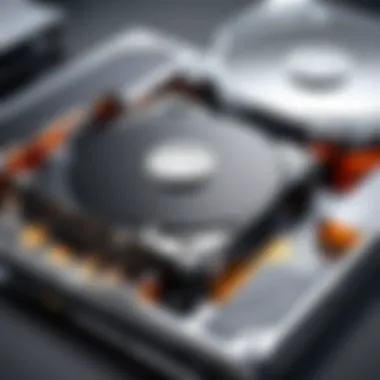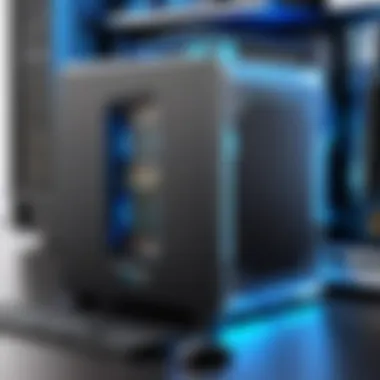Expert Tips for Choosing the Best Storage Hard Drive for Your PC


Product Overview
When it comes to selecting a storage hard drive for your PC, diving into brand information, key specifications, and pricing becomes paramount for making a well-informed decision. Brands like Western Digital, Seagate, and Samsung offer a plethora of options, each varying in capacity, speed, and durability. Understanding these key specifications, such as RPM, cache size, and interface type, will help in gauging the overall performance and compatibility with your PC setup. Pricing is another crucial factor to consider, with high-performance drives typically commanding a premium but ensuring a smoother computing experience.
Performance Comparison
To truly discern the ideal hard drive for your needs, benchmark tests are essential in determining speed and efficiency comparisons. By analyzing read and write speeds, as well as random access times, you can gauge how well a drive performs under various workloads. Solid-state drives (SSDs) often outshine traditional hard disk drives (HDDs) in speed tests, making them a popular choice for gamers and professionals requiring quick access to data.
Features and Technology
Exploring the array of unique features and technological advancements in storage hard drives can shed light on their compatibility with other devices. Features like hardware encryption, shock resistance, and advanced error correction technologies enhance data security and drive longevity. Additionally, considering technologies such as Non-Volatile Memory Express (NVMe) for SSDs can significantly boost transfer speeds and overall system responsiveness.
Pros and Cons
Evaluating the strengths and weaknesses of storage hard drives is crucial for making an informed decision. While SSDs offer lightning-fast speeds and enhanced durability due to their lack of moving parts, they tend to be pricier per gigabyte compared to HDDs. On the other hand, HDDs provide cost-effective storage solutions for bulk data but are typically slower and more prone to mechanical failures. Understanding these pros and cons will assist you in choosing the drive best suited to your specific needs.
Value for Money
Considering the cost-effectiveness and long-term benefits of a storage hard drive is essential in assessing its overall value for money. While SSDs may have a higher upfront cost, their faster performance and energy efficiency can result in long-term savings. Comparing different products in terms of price per gigabyte, warranty periods, and expected lifespan will help in determining the most cost-effective storage solution for your PC setup.
Introduction
In the realm of PC hardware, the selection of a storage hard drive is a crucial decision that can significantly impact overall system performance and functionality. This guide aims to unravel the intricate considerations and nuances involved in choosing the ideal storage drive for your PC setup. By delving into various aspects such as storage options, capacity requirements, performance benchmarks, and future-proofing strategies, this article serves as a comprehensive resource for individuals seeking to optimize their storage solutions.
Understanding Storage Hard Drives
Overview of Storage Options
When exploring storage options for your PC, it is essential to grasp the fundamental disparities between Solid State Drives (SSDs), Hard Disk Drives (HDDs), and Hybrid Drives. SSDs stand out for their lightning-fast readwrite speeds, while HDDs excel in affordability and higher storage capacities. Hybrid drives combine elements of both SSDs and HDDs, offering a balance between performance and cost-efficiency. Understanding these key differences is crucial in aligning your storage choice with your specific requirements and usage patterns.
Importance of Choosing the Right Drive
The significance of selecting the right storage drive cannot be overstated. A drive tailored to your needs can enhance system responsiveness, streamline data access, and improve overall user experience. Conversely, an ill-suited drive may lead to sluggish performance, bottlenecking, and compatibility issues. By prioritizing factors such as speed, reliability, and compatibility, users can ensure that their chosen drive aligns seamlessly with their operational demands and preferences.
Factors to Consider
Storage Capacity Needs
Determining your storage capacity needs is a pivotal starting point in the hard drive selection process. Whether you require ample space for multimedia files, extensive gaming libraries, or professional applications, understanding your storage demands is essential for preventing data overcrowding and system slowdowns. Striking a balance between current requirements and anticipated future growth is key to investing in a drive that accommodates your evolving storage needs effectively.


Performance Requirements
Performance considerations encompass aspects such as data transfer speeds, access times, and overall system responsiveness. Tailoring your drive choice to match your performance expectations ensures smooth multitasking, swift application loading, and enhanced efficiency in data-intensive tasks. By evaluating metrics like readwrite speeds and cache sizes, users can select a drive that aligns with their usage patterns and demands.
Interface Compatibility
Interface compatibility plays a vital role in ensuring seamless integration of the storage drive with your existing hardware setup. Understanding interface standards such as SATA, PCIe, and M.2 facilitates effortless installation and optimized data transfer rates. By confirming compatibility with your motherboard and other components, users can prevent potential incompatibility issues and leverage the full performance potential of their chosen drive.
Types of Storage Hard Drives
Solid State Drives (SSDs)
SSDs are renowned for their rapid data access speeds and superior durability compared to traditional HDDs. By leveraging flash memory technology, SSDs offer enhanced reliability, reduced latency, and energy efficiency, making them an ideal choice for users prioritizing speed and responsiveness in their storage solution.
Hard Disk Drives (HDDs)
HDDs, characterized by rotating platters and magnetic storage, provide cost-effective storage solutions for users requiring large capacities at budget-friendly prices. Although HDDs may lag behind SSDs in speed, they remain a popular choice for mass storage applications where performance outweighs speed considerations.
Hybrid Drives
Hybrid drives combine the best of both worlds, integrating SSD-like performance benefits with HDD-like storage capacities. By intelligently caching frequently accessed data on the SSD component while storing bulk data on the HDD component, hybrid drives offer a balanced approach that optimizes performance and storage space. This hybrid architecture caters to users seeking a compromise between speed and capacity in their storage solution.
Performance Comparison
Speed and Access Times
Speed and access times exemplify the responsiveness and efficiency of a storage drive. SSDs shine in this aspect with near-instantaneous data retrieval and minimal access latencies, enhancing user experience in tasks ranging from booting up the system to loading applications. Consideration of speed and access times is crucial in meeting the demands of users anticipating swift data access and seamless multitasking.
Reliability and Durability
Reliability and durability are paramount considerations in ensuring consistent drive performance and data integrity over time. SSDs typically exhibit higher reliability due to their lack of moving parts, reducing the risk of mechanical failures prevalent in HDDs. By prioritizing reliability and durability, users can safeguard their data against potential drive failures and elevate long-term system stability.
Power Consumption
Power consumption plays a crucial role in determining the energy efficiency and operational costs associated with a storage drive. SSDs, known for their low power consumption and silent operation, offer energy-efficient storage solutions ideal for users seeking to minimize environmental impact and reduce electricity expenses. By evaluating power consumption metrics, users can make informed decisions aligned with their sustainability goals and operational preferences.
Optimizing Storage Solutions
Data Backup Strategies


Implementing robust data backup strategies is imperative in safeguarding critical information and mitigating the risks of data loss. Whether through cloud backups, external hard drives, or automated software solutions, establishing efficient data backup protocols ensures data redundancy and facilitates hassle-free recovery in the event of hardware failures or accidental deletions.
Disk Management Tools
Disk management tools equip users with the necessary utilities to organize, optimize, and maintain their storage drives effectively. From partitioning tools for segregating data to disk cleaning utilities for optimizing drive performance, leveraging disk management tools enhances drive efficiency and prolongs operational lifespan. By incorporating these tools into their maintenance routines, users can streamline drive maintenance and uphold peak performance levels for their storage solution.
Choosing the Right Hard Drive
Assessing Storage Needs
Media Storage
Media storage plays a pivotal role in determining the capacity and performance requirements of a hard drive, especially for users dealing with large files such as multimedia content or high-resolution images. The key characteristic of media storage is its ability to accommodate extensive data efficiently, making it a popular choice for content creators, photographers, and videographers. One unique feature of media storage is its high transfer speeds, enhancing workflow productivity, although it may pose challenges in terms of cost and storage space management.
Gaming Requirements
Gaming requirements focus on the demand for high-speed data access and storage capabilities to support graphic-intensive gameplay and fast loading times. The key characteristic of gaming requirements is low latency and rapid data retrieval, crucial for delivering seamless gaming experiences. Gamers benefit from the swift response times and enhanced performance of hard drives designed to meet gaming needs. However, these specialized drives may come at a premium cost, affecting budget considerations for users.
Professional Applications
Professional applications emphasize the need for reliable and high-capacity storage solutions that can handle complex data processing tasks efficiently. The key characteristic of professional applications is data security and accessibility, essential for industries such as finance, engineering, and data analysis. The unique feature of professional applications lies in their robust encryption and data management capabilities, safeguarding sensitive information. While offering enhanced data protection, these solutions may come with a higher price tag, impacting budget considerations.
Budget Considerations
Cost-Effectiveness
Cost-effectiveness plays a crucial role in determining the financial viability of investing in a particular hard drive solution. The key characteristic of cost-effectiveness is maximizing performance and storage capacity within a set budget, ensuring optimal value for money. Users benefit from cost-effective drives that offer reliable performance at competitive prices, suitable for a range of personal and professional usage scenarios. One unique feature of cost-effective drives is their balance between performance and cost, making them a popular choice for budget-conscious individuals.
Long-Term Investment
Long-term investment focuses on the durability and scalability of a hard drive solution, considering its longevity and future-proofing capabilities. The key characteristic of long-term investment is the ability to adapt to evolving storage needs and technologies over an extended period. Users seeking to optimize their investment benefit from hard drives that offer sustained performance, compatibility with future upgrades, and reliability. The unique feature of long-term investment lies in its potential for longevity and adaptability, ensuring users can continue to benefit from their storage solution in the long run.
Future-Proofing Your System
Scalability
Scalability addresses the capacity of a hard drive to expand and accommodate increased storage demands over time. The key characteristic of scalability is the ability to seamlessly upgrade and enhance storage capacity without compromising performance or data integrity. Users requiring flexibility in their storage solutions benefit from scalable drives that can grow with their evolving needs. One unique feature of scalability is its cost-effective nature, allowing users to incrementally expand storage without significant upfront costs, making it an attractive choice for long-term storage planning.
Upgradability


Upgradability pertains to the ease of upgrading components or features of a hard drive to improve performance or functionality. The key characteristic of upgradability is the accessibility of hardware and software enhancements, enabling users to customize and optimize their storage solution according to changing requirements. Users who value customization and performance enhancement benefit from upgradable drives that offer versatility and longevity. The unique feature of upgradability is its role in future-proofing systems, allowing users to adapt to new technologies and emerging storage trends seamlessly.
Installation and Maintenance
In this detailed guide to choosing a storage hard drive for your PC, the section focusing on Installation and Maintenance plays a crucial role in ensuring the optimal performance and longevity of your storage device. Installation covers the physical setup of the hard drive within your system, while Maintenance encompasses post-installation processes that help keep your drive in top condition.
Installing a Hard Drive
Physical Installation Steps
Physical Installation Steps are a fundamental aspect of integrating a new hard drive into your PC. This process includes opening the PC case, locating the drive bays, connecting power and data cables, securing the drive in place, and closing the case. These steps are essential to ensure the drive functions correctly and is securely mounted within the system.
The key characteristic of Physical Installation Steps lies in its simplicity yet critical nature. Following these steps correctly is vital for the drive to operate efficiently and prevent any damage due to improper installation. This aspect is a popular choice for discussion in this article due to its foundational importance in the overall functioning of the storage drive.
System Configuration
System Configuration refers to the setup and settings that need to be adjusted in your PC's operating system to recognize and utilize the newly installed hard drive. This involves tasks like partitioning the drive, formatting it, assigning a drive letter, and potentially configuring RAID settings. Proper System Configuration ensures that the drive is correctly integrated into your system and can be utilized optimally.
The key characteristic of System Configuration is its role in maximizing the new drive's potential within the PC environment. By configuring the drive correctly, users can customize how the drive is used and accessed by the operating system. This feature is a key point of discussion in this article as it directly impacts the usability and efficiency of the storage solution.
Maintenance Tips
Maintaining your hard drive is essential for ensuring its longevity and preventing data loss. This section covers important practices that help in monitoring the health of the drive and managing factors like fragmentation.
Monitoring Drive Health
Monitoring Drive Health involves using software tools to track the drive's performance metrics, temperature, and overall wellbeing. By regularly monitoring these factors, users can identify potential issues early on and take preventive measures to avoid data loss or hardware failure. This practice is crucial for preserving the integrity of your data and ensuring the drive's optimal operation.
The unique feature of Monitoring Drive Health is its proactive approach to drive maintenance. By continuously monitoring the drive's health status, users can address any looming issues before they escalate into significant problems. This aspect is highly beneficial for users looking to maintain peak drive performance and reliability.
Managing Fragmentation
Managing Fragmentation refers to the process of organizing data on the hard drive to reduce fragmentation, which can impact system performance. This involves running defragmentation tools that rearrange data blocks to optimize read and write operations on the drive. Effectively managing fragmentation helps in enhancing drive efficiency and prolonging its lifespan.
The key characteristic of Managing Fragmentation is its impact on drive speed and overall system responsiveness. By actively managing fragmentation, users can experience improved performance when accessing data stored on the drive. This feature is considered essential in this article as it directly contributes to the drive's longevity and overall functionality.
Conclusion
In the realm of selecting the appropriate storage hard drive for your PC, the conclusion plays a pivotal role in bringing together all the intricate details explored throughout this guide. The final thoughts encapsulate the essence of the decision-making process, highlighting the paramount importance of making an informed and strategic choice. As technology continues to advance at a rapid pace, the conclusion serves as a compass, guiding users towards selecting a storage solution that aligns with their present requirements while being adaptable to future needs.
One of the key benefits of delving into the conclusion is gaining a holistic understanding of the criteria to consider when choosing a storage hard drive. Whether it's assessing storage capacity needs, performance requirements, or compatibility factors, the conclusion reinforces the significance of a well-thought-out decision. By synthesizing the information presented in this guide, users are equipped with the knowledge to make a definitive choice that caters to their unique usage scenarios, be it for media storage, gaming, or professional applications.
Moreover, the conclusion brings to light the value of future-proofing one's system through scalability and upgradability. By emphasizing these aspects, users are encouraged to not only meet their current storage demands but also anticipate and accommodate for future growth and advancements in technology. This forward-thinking approach ensures that the chosen storage hard drive will remain relevant and functional as computing requirements evolve over time.
In essence, the conclusion serves as the cornerstone of this comprehensive guide, empowering users with the insights and considerations necessary to make a well-informed decision when selecting a storage hard drive for their PC. By emphasizing the importance of thoughtful deliberation and strategic planning, the conclusion cements the guide's role as an essential resource for individuals seeking to optimize their storage solutions.







